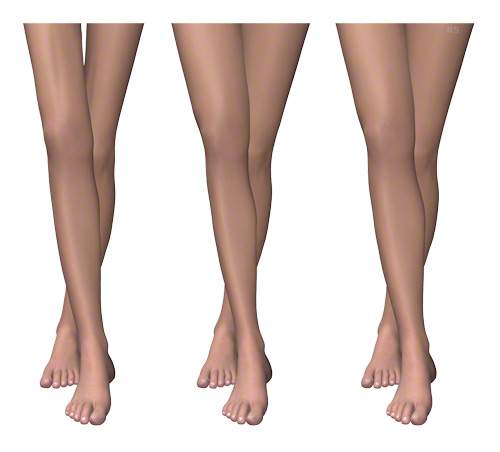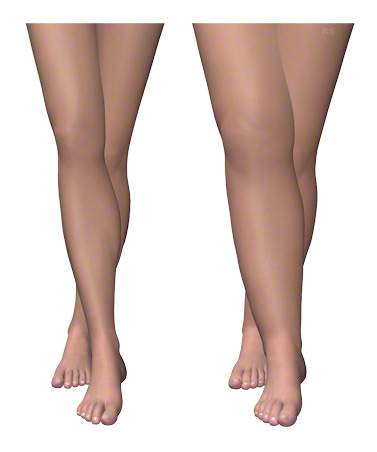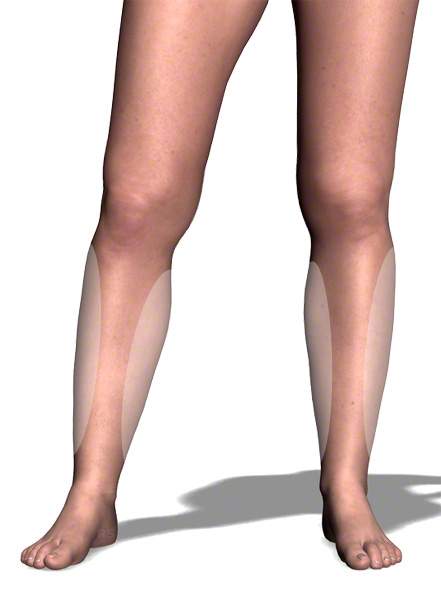In this article you will find information on surgical and non-surgical calf correction(calf augmentation or reduction, calf surgery) at the Yuveo Clinic in Düsseldorf.
Here we answer your questions about the different types of calf surgery and the reasons for having your calves treated at the Yuveo Clinic.
Contents
Yuveo Clinic
Special features of calf correction
Fat or muscle – what needs to be treated? This is the crucial question in calf correction.
Calf correction
Reasons for a calf correction
Medical reasons
The reasons for calf surgery can be genetically too small or too large calves. It may be due to muscle changes or fat deposits.
A malformation of the calves can also be caused by various diseases and, in these cases in particular, can take on extreme forms, which can also be associated with severe asymmetry = inequality, making it necessary to enlarge or reduce the size of the calves.
These conditions, which result in muscular changes in the calf, include
- Clubfoot
- spastic paralysis
- Polio (poliomyelitis)
- Bone inflammation (osteomyelitis)
- Injuries such as burns, extensive bruising, bone fractures and nerve injuries with muscle atrophy.
- Localized obesity (obesity)
- Generalized obesity
- Lipedema (fat distribution disorder, form of lipomatosis)
Aesthetic reasons
Many of our Düsseldorf patients want a calf correction for purely aesthetic reasons. The calves are individually perceived as much too small or too large. If the findings are plausible and this is accompanied by significant psychological suffering and possibly restrictions in social terms, a calf correction can mean a significant improvement in quality of life.
Today, there are various procedures which, in the practiced hands of our plastic surgeons, lead to good to very good results with a low risk of complications.


Frequently asked questions about calf correction
Are the calves muscular or fatty?
Before you consider a surgical calf correction, you should consult the Yuveo team to determine whether the change is caused by an increase in muscle massor a fat distribution disorder.
We can easily determine this by pinching the skin and subcutaneous fatty tissue. What we can grasp between our fingers is fatty tissue. If it is only 0.5-1 cm, calf correction by liposuction is pointless if the calf is too large, as it is an increase in muscle tissue.
Which calf surgery in Düsseldorf makes sense and when?
If sport and conservative therapy do not lead to a satisfactory result and the level of suffering is high, or if there are pathological changes with a corresponding level of suffering, the following calf correction options are available:
- Liposuction: In the case of fat deposits, we can correct both the calves and the ankles and thus achieve a calf reduction.
- Calf reduction on the calf muscleThe most effective method is the removal of a calf muscle. Partial removal is somewhat less effective. Another option is the denervation of this muscle = disconnecting the nerve supply. These invasive forms of calf correction and Btx treatment to reduce the size of the calf have no long-term effect on function as, despite its volume, it is only an auxiliary muscle whose tasks can be taken over by other muscles.
- Calf augmentationSurgical calf augmentation in Düsseldorf is possible by means of calf implants, hyaluronic acid (shelf life approx. 1.5 years) or autologous fat transplantation at the Yuveo Clinic.
What do you need to know about liposuction on the calves?
Liposuction of fat on the lower legs is a particular challenge. This is why only a few plastic surgeons, including the team at the Yuveo Clinic Düsseldorf, offer this procedure.
Fat pads on the calf and ankles
Many women complain about fat pads on their calves and/or ankles. Especially slim women can suffer greatly because of their otherwise normal appearance. A calf reduction is desired.
Extremely thick calves are often caused by so-called lipedema, which extends to the hips and can be treated excellently in many cases by removing the fat in Düsseldorf.
When does liposuction on the calves and ankles make sense?
Fat or water in the calf? – Liposuction of the calves and ankles is indicated if the cause is fat deposits. It is very important to rule out internal diseases / general illnesses. Liposuction is not the method of choice for water retention (edema), which often occurs as a result of heart disease or kidney damage, among other things! In this case, the underlying diseases must be treated.
Muscle development – It is also particularly important to check the amount of muscle in the calf. Some women have a genetically enlarged calf muscle with only a small amount of fatty tissue and usually slim ankles. In such cases, liposuction of the fat on the lower leg makes no sense. Other options for calf correction must then be considered.
A calf reduction on the muscle can be performed surgically with Btx or to a lesser extent by reducing the load and strain.
What are the special features of liposuction on the lower leg?
If a clear layer of fat can be felt and the calf muscle is of normal size, good and very good results can be achieved by removing fatty tissue. However, excessive thinning can lead to irregularities in the skin surface. Superficial nerves must be spared.
The fat deposits are limited to certain areas or occur in general (calves or ankles or pads below the knee). We have to take this into account. As a rule, your plastic surgeons can manage well with 2-4 puncture sites per side.
What is the aftercare for liposuction on the lower leg?
As after any liposuction of the body’s own fat, compression therapy (compression stocking) and a certain amount of rest for approx. 6 weeks is recommended when correcting the calf and ankles. The legs should also be elevated.
In the first few days in particular, we administer painkillers and initiate decongestant measures. If the incision sites are sutured, we can generally remove the stitches after approx. 1 week at the clinic in Düsseldorf. Depending on the extent of the liposuction, sports that involve movement and strain on the thighs should be avoided for 6 weeks.
Sources:
- Plastic Surgery – Mathes – 8 Volumes – Saunders; Edition: Uitgawe – 2005
- Aesthetic surgery – Lemperle, von Heimburg – Ecomed – 2008 – (ring binder)
- Aesthetic Surgery Video I: Local anesthesia and superficial liposuction by Gottfried Lemperle from ecomed – 2001
- Aesthetic surgery Video IV: Ultrasonic liposuction and CO2 laser treatment by Gottfried Lemperle from ecomed – 2003
What is the follow-up treatment after calf correction at our clinic in Düsseldorf?
We cannot generalize the form of aftercare, as it depends on the respective correction of the calves.
Even in the case of liposuction, we have to make the decision not to exercise and the need for compression garments dependent on the extent of the procedure.
You can find further information on aftercare in the corresponding specialist articles.
Fact check
As calf correction is carried out using very different methods, an individual fact check is not possible here. You will find the details in the special treatments for calf correction.
Further information and related topics
Technical terms:
- Lipedema = Fat distribution disorder
- Musculus gastrocnemius = one calf muscle
- Calfplasty = correction of the calves
Related topics:


